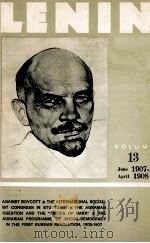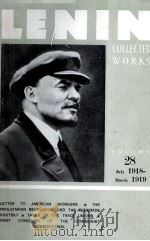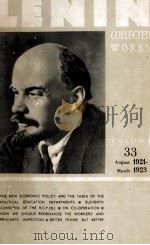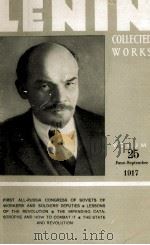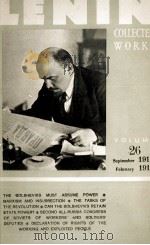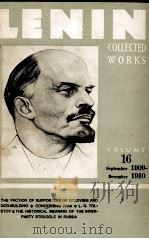《COLLECTED WORKS VOLUME 3》
| 作者 | 编者 |
|---|---|
| 出版 | FOREIGN LANGUAGES PUBLISHING HOUSE |
| 参考页数 | 659 |
| 出版时间 | 1897(求助前请核对) 目录预览 |
| ISBN号 | 无 — 求助条款 |
| PDF编号 | 812479128(仅供预览,未存储实际文件) |
| 求助格式 | 扫描PDF(若分多册发行,每次仅能受理1册) |
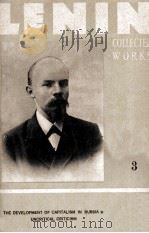
THE DEVELOPMENT OF CAPITALISM IN RUSSIA.The Process of the Formation of a Home Market for Large-Scale Industry21
Preface to the First Edition25
Preface to the Second Edition31
Chapter Ⅰ. The Theoretical Mistakes of the Narodnik Economists37
Ⅰ.The Social Division ofLabour37
Ⅱ. The Growth of the Industrial Population at the Ex-pense of the Agricultural40
Ⅲ. The Ruin of the Small Producers41
Ⅳ. The Narodnik Theory of the Impossibility of Real-ising Surplus-Value43
Ⅴ. The Views of Adam Smith on the Production and Circulation of the Aggregate Social Product in Capi-talist Society and Marx's Criticism of These Views47
Ⅵ. Marx's Theory of Realisation51
Ⅶ.The Theory of the National Income58
Ⅷ.Why Does the Capitalist Nation Need a Foreign Market?64
Ⅸ. Conclusions from Chapter Ⅰ67
Chapter Ⅱ. The Differentiation ofthe Peas-antry70
Ⅰ.Zemstvo Statistics for Novorossia70
Ⅱ.Zemstvo Statistics for Samara Gubernia85
Ⅲ.Zemstvo Statistics for Saratov Gubernia93
Ⅳ.Zemstvo Statistics for Perm Gubernia106
Ⅴ. Zemstvo Statistics for Orel Gubernia112
Ⅵ.Zemstvo Statistics for Voronezh Gubernia115
Ⅶ. Zemstvo Statistics for Nizhni-Novgorod Gubernia119
Ⅷ.Review of Zemstvo Statistics for Other Gubernias122
Ⅸ.Summary of the Above Zemstvo Statistics on the Differentiation of the Peasantry127
Ⅹ.Summary of Zemstvo Statistics and Army-Horse Census Returns141
Ⅺ. A Comparison of the Army-Horse Censuses of 1888-1891 and 1896-1900146
Ⅻ.Zemstvo Statistics on Peasant Budgets148
ⅩⅢ. Conclusions from Chapter Ⅱ172
Chapter Ⅲ. The Landowners' Transition from Corvee to Capitalist Economy191
Ⅰ. The Main Features of Corvee Economy191
Ⅱ. The Combination of the Corvee and the Capitalist Systems of Economy193
Ⅲ. Description of the Labour-Service System198
Ⅳ. The Decline of the Labour-Service System205
Ⅴ. The Narodnik Attitude to the Problem210
Ⅵ. The Story of Engelhardt's Farm215
Ⅶ. The Employment of Machinery in Agriculture219
Ⅷ. The Significance of Machinery in Agriculture228
Ⅸ. Wage-Labour in Agriculture237
Ⅹ. The Significance of Hired Labour in Agriculture242
Chapter Ⅳ. The Growth of Commercial Agri-culture252
Ⅰ. General Data on Agricultural Production in Post-Re-form Russia and on the Types of Commercial Agri-culture252
Ⅱ.The Commercial Grain-Farming Area257
Ⅲ.The Commercial Stock-Farming Area. General Data on the Development of Dairy Farming261
Ⅳ. Continuation. The Economy of Landlord Farmingin the Area Described267
Ⅴ. Continuation. The Difierentiation of the Peasantry in the Dairy-Farming Area275
Ⅵ.The Flax-Growing Area282
Ⅶ. The Technical Processing of Agricultural Produce287
Ⅷ. Industrial Vegetable and Fruit Growing; Suburban Farming304
Ⅸ.Conclusions on the Significance of Capitalism in Rus-sian Agriculture310
Ⅹ. Narodnik Theories on Capitalism in Agriculture."The Freeing of Winter Time"318
Ⅺ. Continuation.—The Village Community.—Marx's View on Small-Scale Agriculture.—Engels's Opinion of the Contemporary Agricultural Crisis323
Chapter Ⅴ. The First Stages of Capitalism in Industry331
Ⅰ.Domestic Industry and Handicrafts331
Ⅱ. Small Commodity-Producers in Industry.The Craft Spirit in the Small Industries334
Ⅲ. The Growth of Small Industries after the Reform.Two Forms of This Process and Its Significance338
Ⅳ. The differentiation of the Small Commodity-Producers.Data on House-to-House Censuses of Handicraftsmen in Moscow Gubernia344
Ⅴ. Capitalist Simple Co-operation356
Ⅵ. Merchant's Capital in the Small Industries360
Ⅶ. "Industry and Agriculture"369
Ⅷ. "The Combination of Industry with Agriculture"378
Ⅸ. Some Remarks on the Pre-capitalist Economy of Our Countryside380
ChapterⅥ.Capitalist Manufacture and Capi-talist Domestic Industry384
Ⅰ. The Rise of Manufacture and Its Main Features384
Ⅱ.Capitalist Manufacture in Russian Industry386
1) The Weaving Industries386
2) Other Branches of the Textile Industry.The Felt Trade390
3) The Hat-and-Cap and Hemp-and-Rope Trades393
4) The Wood-Working Trades397
5) The Processing of Livestock Produce The Leather and Fur Trades402
6) The Remaining Livestock Processing Trades409
7) The Processing of Mineral Products413
8) The Metal Trades.The Pavlovo Industries415
9) Other Metal Trades419
10) The Jewellery, Samovar and Accordion Trades422
Ⅲ. Technique in Manufacture. Division of Labour and Its Significance427
Ⅳ.The Territorial Division of Labour and the Separa-tion of Agriculture from Industry431
Ⅴ. The Economic Structure of Manufacture435
Ⅵ. Merchant's and Industrial Capital in Manufacture.The "Buyer-up" and the "Factory Owner"438
Ⅶ. Capitalist Domestic Industry as an Appendage of Manufacture441
Ⅷ. What Is "Handicraft" Industry?448
ChapterⅦ.The Development of Large-Scale Machine Industry454
Ⅰ. The Scientific Conception of the Factory and the Significance of "Factory" Statistics454
Ⅱ. Our Factory Statistics456
Ⅲ. An Examination of Historico-Statistical Data on the Development of Large-Scale Industry468
1) Textile Trades469
2) Wood-Working Industries474
3) Chemical,Livestock Product and Ceramic Industries475
4) Metallurgical Industries478
5) Food Industries479
6) Excise-Paying and Other Trades481
7) Conclusions483
Ⅳ. The Development of the Mining Industry484
Ⅴ.Is the Number of Workers in Large Capitalist Enter-prises Growing?496
Ⅵ. Steam-Engine Statistics507
Ⅶ. The Growth of Large Factories509
Ⅷ. The Distribution of Large-Scale Industry517
Ⅸ. The Development of the Lumber and Building Industries524
Ⅹ. The Appendage to the Factory533
Ⅺ. The Complete Separation of Industry from Agriculture535
Ⅻ. Three Stages in the Development of Capitalism in Russian Industry540
ChapterⅧ.The Formation of the Home Mar-ket551
Ⅰ. The Growth of Commodity Circulation551
Ⅱ.The Growth Of The Commercial And Industrial Population556
1)The Growth Of The Towns556
2)The Significance Of Home Colonisation561
3)The Growht Of Factory And Of Commerclal And Ind ustrial Townships And Villages565
4)Non-Agricultural Outside Employments567
Ⅲ.THE CROWTH OF THE EMPLOYMENT OF WAGE-LABOUR580
Ⅳ.THE FORMATION OF A HOME MARKET FOR LABOUR-POWER585
Ⅴ.THE SIGNIFICANCE OF THE BORDER REGIONS HOME OR FOREIGN MARKET?590
Ⅵ.THE "MISSION"OF CAPITALISM595
UNCRITICAL CRITICISM609
Ⅰ611
Ⅱ618
Ⅲ624
NOTES633
1897《COLLECTED WORKS VOLUME 3》由于是年代较久的资料都绝版了,几乎不可能购买到实物。如果大家为了学习确实需要,可向博主求助其电子版PDF文件(由 1897 FOREIGN LANGUAGES PUBLISHING HOUSE 出版的版本) 。对合法合规的求助,我会当即受理并将下载地址发送给你。
高度相关资料
-
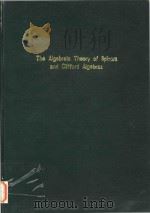
- Collected works Volume 2
- 1997 Springer
提示:百度云已更名为百度网盘(百度盘),天翼云盘、微盘下载地址……暂未提供。➥ PDF文字可复制化或转WORD
